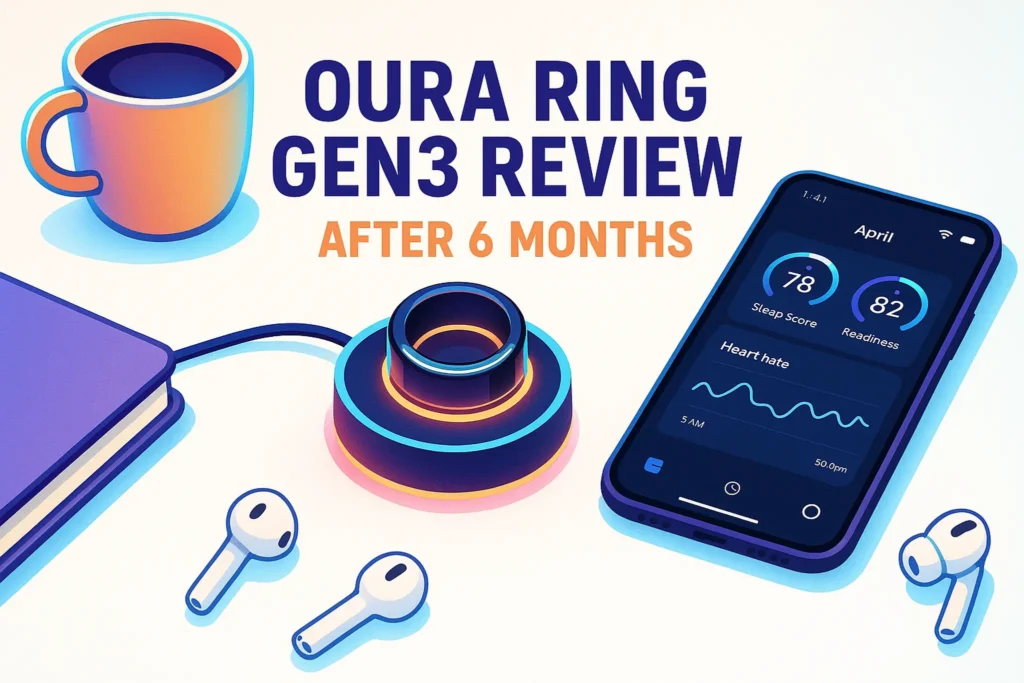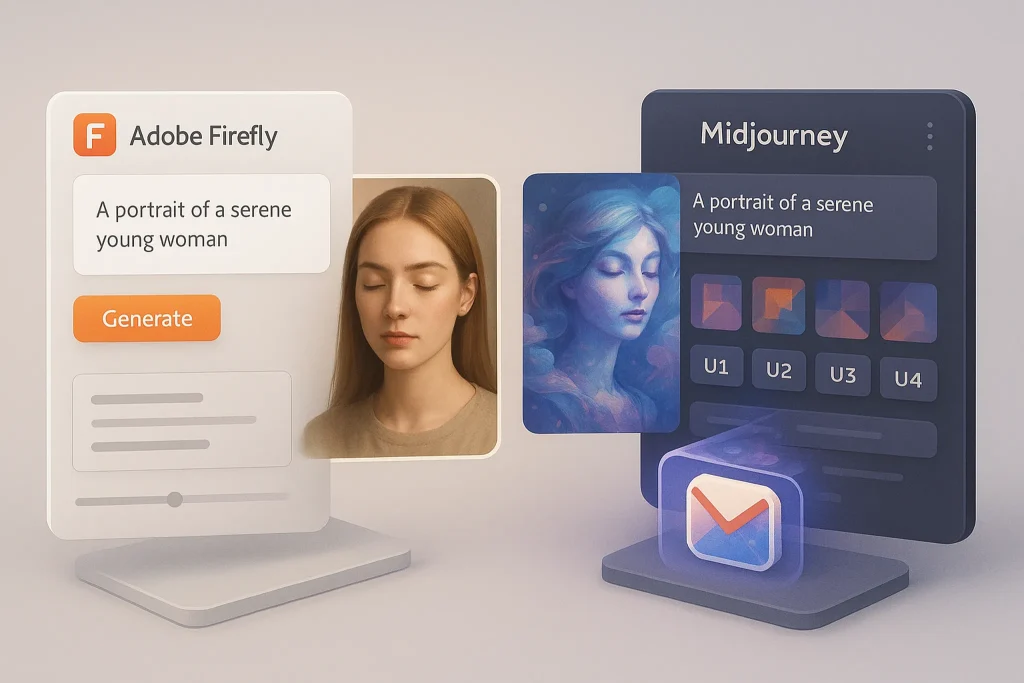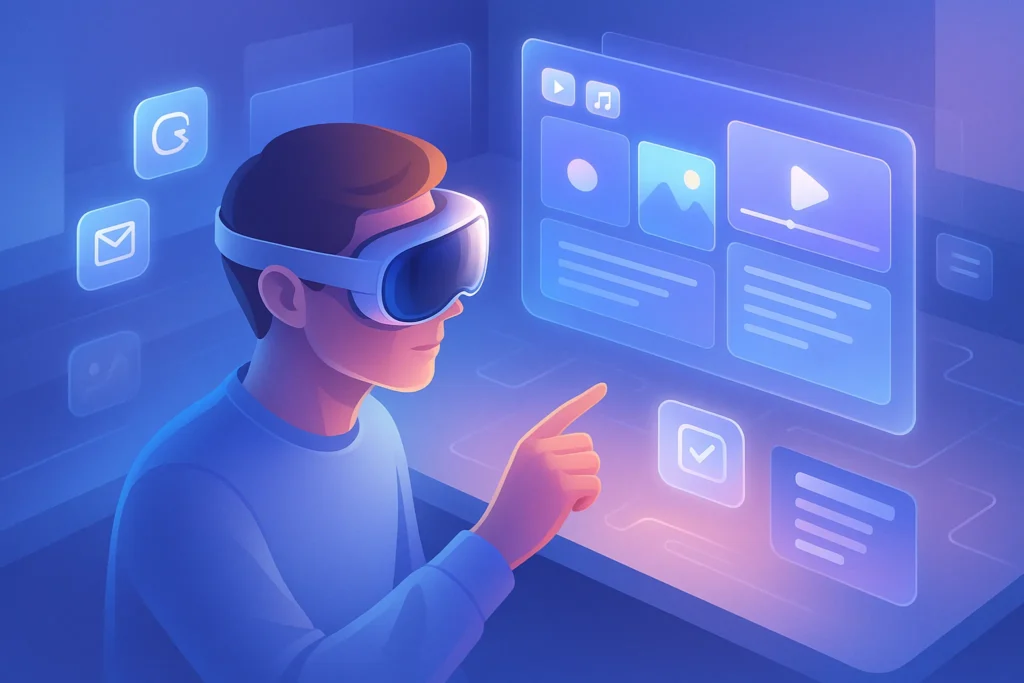Intro:
Wearable technology has come a long way from bulky fitness trackers and oversized smartwatches. In 2025, the Oura Ring Gen 3 has become one of the most talked-about smart rings, blending sleek design with deep health insights. But what happens after the honeymoon phase—when you’ve lived with it every single day for half a year?
This is not a quick “out of the box” review. This is a 6-month real-world test where comfort, accuracy, battery, and lifestyle integration matter more than specs on paper.
💬 If you’re wondering whether a ring can really replace—or even outperform—a smartwatch like the Apple Watch Ultra 2 for runners and everyday users, this review will give you the answers.
🧠 First Impressions vs. 6-Month Reality
When you first unbox the Oura Ring Gen 3, it feels futuristic. A piece of jewelry that doubles as a health lab on your finger. But fast-forward six months, and the reality sets in.
-
✅ Design: Still impressively minimal. Unlike bulkier trackers, it doesn’t scream “tech.” People often mistake it for a regular ring. That’s a win for style.
-
✅ Comfort: Surprisingly comfortable for all-day wear. I tested it during typing sessions, gym workouts, and even while sleeping. It never snagged or felt intrusive.
-
❌ Durability: After 6 months, micro-scratches are visible, especially if you’re rough on your hands. The finish isn’t indestructible.
-
✅ Battery Life: Stays at 4–6 days on a single charge. Even after months of cycles, degradation is minimal.
A gadget only earns its spot in your daily routine if it fades into the background. Does your current wearable pass that test?
💬 Accuracy of Tracking: Can a Ring Beat a Watch?
The Oura Ring Gen 3 has carved its reputation around sleep tracking, but let’s dig deeper.
Over six months, I compared Oura’s data against other wearables and apps (including Garmin, Fitbit, and the Smart Rings That Track Sleep & Fitness category). The results?
-
Sleep: Oura’s data was consistently closer to polysomnography (lab-grade sleep testing) than many mainstream watches. Sleep stages—light, deep, REM—felt more aligned with actual restfulness than, say, a Fitbit.
-
Heart Rate: Resting heart rate was highly accurate, but during high-intensity workouts, Oura lags. Unlike wrist wearables that capture rapid spikes, the ring is slower to update.
-
Readiness Score: A signature Oura metric, blending recovery, sleep, and activity. After six months, I noticed its suggestions (e.g., “Take a lighter day today”) often aligned with how my body actually felt.
💡 Here’s where Oura stands out: it’s less about obsessing over workout splits and more about holistic health—balancing activity with recovery. For athletes, it won’t replace a dedicated sports watch, but for lifestyle users, it’s enough.
📌 For those focused on broader trends, our Wearable Tech in 2025 guide shows how smart rings are redefining health tracking.
🎨 Mini-Comparison
Oura Ring Gen 3 vs Apple Watch Ultra 2
Oura: Discreet, focused on sleep and recovery, 4–6 day battery.
Ultra 2: Feature-rich, GPS + workouts, 1–2 day battery.
Verdict: For runners and outdoor adventurers, the watch wins. For recovery-driven lifestyles, Oura shines.
📌 Our full Apple Watch Ultra 2 Review for Runners dives deeper into performance-focused wearables.
✅ Everyday Usability: Beyond Just Sleep
One of the biggest concerns with any wearable is whether it becomes a daily habit or a drawer gadget. Six months in, here’s how Oura performs:
-
Daytime Tracking: Steps, calories, and general activity tracking are fine—but not groundbreaking. If you’re upgrading from a dedicated fitness tracker, you may miss advanced metrics.
-
Nighttime Advantage: This is where Oura dominates. Sleep trends, HRV (heart rate variability), and readiness scores actually influenced my choices—like skipping late-night screen time after seeing how it hurt my recovery.
-
Lifestyle Integration: Oura’s companion app is one of the best-designed in the wearables space. The coaching insights, while not always personalized, feel more actionable than generic “10k steps” reminders.
💬 Oura doesn’t nag you to move. It nudges you to recover smarter.
📌 If you’re curious about balancing recovery with performance, our Tech for Fitness roundup highlights other tools worth exploring.
🔋 Battery, Charging & Real-World Performance
Battery is often where wearables fall apart. Six months in, the Oura Ring Gen 3 remains surprisingly consistent.
-
Charging Time: From 0 to 100% in about 80 minutes.
-
Longevity: After months of cycles, it still lasts around 5 days on average. This means you can forget the charger on a weekend trip and not panic.
-
Charger Design: The proprietary dock is sleek but can be a pain if you lose it. Unlike USB-C chargers for phones or watches, you can’t just borrow one.
👉 Thinking about getting the Oura Ring Gen 3? If you’re serious about sleep and recovery tracking, it’s one of the best long-term investments in wearable health.
🎯 Who Is Oura Ring Gen 3 Really For?
Not every wearable is for everyone. After six months, here’s the profile of someone who benefits most:
-
Wellness-First Professionals: People who want insights into stress, recovery, and sleep without looking like they’re wearing tech.
-
Sleep-Obsessed Users: If your main concern is sleep optimization, nothing else matches Oura’s depth.
-
Minimalists: Those who hate wristbands and prefer something discreet.
-
Biohackers: Oura’s HRV and readiness metrics give useful data for optimizing routines.
⚠️ But if you’re a hardcore runner or triathlete, Oura won’t replace your Garmin, Coros, or Apple Watch.
📌 For multi-device setups, check out our feature on Smart Rings That Track Sleep & Fitness—where we explore stacking Oura with performance trackers.
📱 Long-Term App Experience & Subscription Model
A wearable is only as good as its app—and Oura knows this. After six months, the Oura app has become the central hub of my health data.
-
Interface: Sleek, clean, and easy to interpret. Charts and readiness scores feel approachable, not overwhelming.
-
Insights: Daily nudges, like “You might benefit from winding down earlier tonight,” are surprisingly accurate once the app learns your habits.
-
Subscription: Oura requires a membership for full features. At first, this felt frustrating, but after six months, I’ve come to accept it. The evolving insights and historical trends justify the ongoing cost—especially compared to other wearables where data feels static.
💡 If you’ve ever tried juggling multiple health apps, you’ll appreciate Oura’s simplicity. Unlike certain tools that bury insights behind dashboards, Oura surfaces what matters most.
👉 For a broader view on how apps shape wearable experiences, you can check our guide on Wearable Tech in 2025, where we compare the app ecosystems of rings, watches, and hybrid devices.
🏋️ Durability & Lifestyle Test: Does It Survive Real Life?
One of the biggest questions people ask is: “Can a ring really handle workouts, showers, and everyday bumps?” After six months of wearing it everywhere, here’s the verdict.
-
Gym & Lifting: For weightlifters, gripping heavy bars sometimes presses the ring uncomfortably. It doesn’t break, but you’ll notice it.
-
Swimming: Oura is water-resistant up to 100 meters. I tested it in pools and open water—it held up fine, no data loss.
-
Travel: On long trips, its discreet size made it far easier to wear than lugging around a charger for a bulky smartwatch.
📝 Nerd Tip: If you’re into intense training, pairing Oura with a performance tracker like Garmin or even the Apple Watch Ultra 2 gives you the best of both worlds—Oura for recovery, watch for workouts.
🎨 Pros & Cons After 6 Months
✅ Pros:
-
Excellent sleep tracking accuracy
-
Comfortable and discreet design
-
4–6 days battery life still holding strong
-
Actionable readiness score and recovery insights
-
App offers meaningful nudges, not generic reminders
❌ Cons:
-
Membership subscription feels like a lock-in
-
Workout tracking lags behind wrist devices
-
Micro-scratches show with heavy use
-
Proprietary charger is inconvenient if lost
📬 Want to Sleep Smarter in 2025?
Join our free newsletter and get weekly insights on sleep tech, recovery wearables, and fitness gadgets—delivered straight to your inbox.
Actionable, science-backed, and curated for creators and professionals who want peak energy.
🔐 100% privacy. No spam. Just proven strategies and tools for better sleep, focus, and recovery.
🧠 How Oura Changed My Habits (Real-World Impact)
Perhaps the most underrated part of living with Oura isn’t the numbers—it’s the behavioral changes.
Six months in, I’ve found myself:
-
Going to bed earlier, because I can see the cost of late-night screen time in my readiness score.
-
Taking active recovery days instead of pushing through fatigue, improving consistency in workouts.
-
Drinking less caffeine in the evenings, after noticing the HRV (heart rate variability) impact.
📌 These are small nudges, but over time, they compound. This is why Oura stands apart from many “step counters.” It’s not just about logging numbers—it’s about coaching you into better decisions.
👉 If habit-building interests you, we also explored tech-driven habit change in our feature on Tech for Fitness, where devices like Oura act as quiet accountability partners.
📊 Comparison Table: Oura Ring Gen 3 vs Apple Watch Ultra 2 vs WHOOP 4.0
| Feature | Oura Ring Gen 3 | Apple Watch Ultra 2 | WHOOP 4.0 |
|---|---|---|---|
| Form Factor | Smart ring (jewelry-like, discreet) | Rugged smartwatch (large screen) | Strap-based fitness band |
| Main Focus | Sleep & recovery tracking | Performance, GPS, lifestyle apps | Recovery & strain tracking |
| Battery Life | 4–6 days | 1–2 days | ~4–5 days |
| Workout Tracking | Basic (limited accuracy for HIIT) | Advanced (GPS, heart rate, splits) | Detailed strain scoring, HR monitoring |
| Sleep Tracking | Industry-leading, lab-grade accuracy | Decent, but not as advanced | Strong sleep and recovery focus |
| Comfort | Very comfortable, barely noticeable | Bulky but manageable | Lightweight strap, 24/7 wear |
| Durability | Water-resistant 100m, prone to scratches | Extremely rugged, swim-ready | Sweat/water resistant |
| App Experience | Intuitive, lifestyle-focused | Feature-rich, Apple ecosystem | Recovery-focused, requires subscription |
| Subscription | Required for insights ($) | Optional for premium fitness+ | Required for full features ($) |
| Best For | Minimalists, sleep hackers, wellness-focused pros | Athletes, outdoor adventurers, iOS ecosystem users | Recovery junkies, performance trainers |
📝 Don’t just look at features—ask yourself which wearable matches your lifestyle. Do you need detailed splits, or smarter recovery insights?
👥 Real-Life Use Cases: How Different People Benefit
One of the best ways to understand Oura’s real value is to see how different people use it. After six months, these are three real-world scenarios where the ring made the biggest difference:
-
The Remote Worker Fighting Jet Lag
A digital nomad moving between Europe and Asia used Oura to track circadian rhythm shifts. By following readiness and sleep scores, they adjusted flight schedules and minimized jet lag, arriving fresher for meetings. -
The Everyday Runner
A casual runner paired Oura with an Apple Watch. The watch tracked pace and mileage, while Oura highlighted recovery deficits. This combination prevented overtraining injuries and improved consistency. -
The Biohacker
A health enthusiast monitored HRV trends with Oura and experimented with meditation and cold exposure. Oura’s data showed measurable improvements, proving these habits weren’t just placebo.
💬 Takeaway: The same device adapts to very different lifestyles, which is what makes Oura versatile.
🧪 Scientific Validation: Data Beyond Marketing
The Oura Ring Gen 3 isn’t just consumer hype—it has been used in scientific studies and research projects.
-
Sleep Labs: Universities have validated its sleep stage detection against polysomnography, showing closer accuracy than most mainstream trackers.
-
COVID Detection: During the pandemic, Oura partnered with research institutions to explore early illness detection using HRV and body temperature trends.
-
Sports Recovery: Professional teams have experimented with Oura to monitor readiness scores across training camps.
This scientific backing strengthens Oura’s credibility—it’s not just lifestyle tech, but a tool recognized in research environments.
🔍 Competitor Landscape: The Rings of 2025
While Oura dominates today, new players are entering the space:
-
Ultrahuman Ring Air: Focused on metabolism and glucose insights, targeting hardcore biohackers.
-
Circular Ring: Promises deeper personalization with AI-driven insights.
-
Samsung Smart Ring (upcoming): Expected to integrate with the Galaxy ecosystem, bringing smart rings mainstream.
📌 This competition shows one thing: the smart ring market is no longer niche. If you want to understand where it’s heading, our feature on Wearable Tech in 2025 maps out these shifts in detail.
⚡ Nerd Tips: Getting the Most Out of Your Oura Ring
Oura isn’t just “wear and forget.” After six months, here are advanced tips to maximize its impact:
-
Leverage HRV Trends: Don’t just look at daily numbers—track 2–4 week averages to truly see lifestyle effects.
-
Sync with Apple Health or Google Fit: Integrating data gives you a full health profile across devices.
-
Use Readiness to Guide Training: A low readiness day doesn’t mean no movement; it means swap high-intensity training for mobility or yoga.
-
Bedtime Routine: Use Oura’s bedtime reminders to create consistency. Over time, this is the single most effective way to improve sleep scores.
📝 The ring gives you data. You create change by acting on it.
🛒 Where to Buy Oura Ring Gen 3 Safely in 2025
If you’re ready to try Oura, make sure you purchase from trusted sources.
-
Official Oura Website → Best for full warranty and customer support.
-
Amazon Authorized Sellers → Convenient shipping and occasional discounts.
🧠 Nerd Verdict
After six months, the Oura Ring Gen 3 has earned its place as the best sleep and recovery tracker for everyday wear. It’s not a replacement for hardcore fitness watches, but it was never designed to be.
Where it shines is in its subtlety: a piece of jewelry that continuously nudges you toward better choices without feeling like surveillance tech. The battery still holds up, the app grows more useful with time, and the impact on daily habits is real.
If your goal in 2025 is to optimize recovery, stress, and sleep without strapping a mini-computer to your wrist, Oura remains unmatched.
❓ FAQ: Real Questions About the Oura Ring Gen 3
💬 Would You Bite?
If you had to choose one wearable for the next six months, would you go for a ring that optimizes recovery, or a watch that tracks performance?
Drop your take—I’m curious where you stand.👇



